
LN Andromedae, also known as HD 217811, HR 8768, is a formerly suspected variable star in the constellation Andromeda. Located approximately 458 parsecs (1,490 ly) away from Earth, it shines with an apparent visual magnitude 6.41, thus it can be seen by the naked eye under very favourable conditions. Its spectral classification is B2V, meaning that it's a hot main sequence star, emitting light approximately with a blackbody spectrum at an effective temperature of 18,090 K.
WR 114 is a Wolf-Rayet star in the constellation of Scutum. It is an early type star of the carbon sequence (WCE) classified as WC5.

IK Tauri or NML Tauri is a Mira variable star located about 280 parsecs (910 ly) from the Sun in the zodiac constellation of Taurus.
QV Andromedae is an Alpha2 Canum Venaticorum variable in the constellation Andromeda. Its maximum apparent visual magnitude is 6.6, so it can be seen by the naked eye under very favourable conditions. The brightness varies slightly following a periodic cycle of approximately 5.23 days.
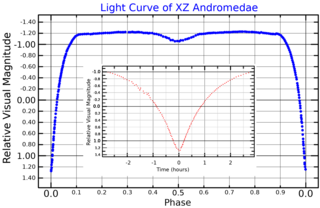
XZ Andromedae is a binary star in the constellation Andromeda. Its maximum apparent visual magnitude is 9.91, but drops down to 12.45 every 1.357 days. Its variability matches the behaviour of Algol variable stars.

AB Andromedae is a binary star in the constellation Andromeda. Paul Guthnick and Richard Prager discovered that the star is an eclipsing binary in 1927. Its maximum apparent visual magnitude is 9.49 but shows a variation in brightness down to a magnitude of 10.46 in a periodic cycle of roughly 8 hours. The observed variability is typical of W Ursae Majoris variable stars, so the two stars in this system form a contact binary.

AD Andromedae is an eclipsing binary in the constellation Andromeda. Its maximum apparent visual magnitude is 11.2, but it shows a decrease of 0.62 magnitudes during the main eclipse and 0.58 during the secondary one. It is classified as a Beta Lyrae variable star with a period of almost one day.
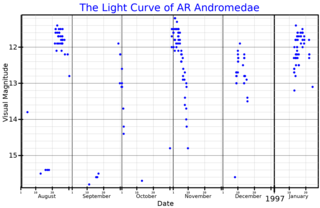
AR Andromedae is a dwarf nova of the SS Cygni type in the constellation Andromeda. Its typical apparent visual magnitude is 17.6, but increases up to 11.0 magnitude during outbursts. The outbursts occur approximately every 23 days.

BM Andromedae is a T Tauri star in the constellation Andromeda. Its apparent visual magnitude has irregular variations between a maximum of 11.63 and a minimum of 14.02.

BX Andromedae is an eclipsing binary star in the constellation Andromeda. Its maximum apparent visual magnitude is 8.87. Within a cycle of approximately 14.6 hours, the brightness drops down to a magnitude of 9.53 during the main eclipse, and to a magnitude of 9.12 during the secondary one. It is classified as a Beta Lyrae variable.

CC Andromedae is a variable star in the constellation Andromeda. It is a pulsating star of the Delta Scuti type, with an apparent visual magnitude that varies between 9.19 and 9.46 with a periodicity of 3 hours.
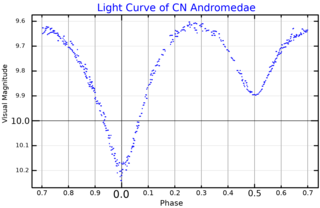
CN Andromedae is an eclipsing binary star in the constellation Andromeda. Its maximum apparent visual magnitude is 9.62 and drops down to a minimum of 10.2 during the main eclipse. It is classified as a Beta Lyrae variable with a period roughly of 0.4628 days.

EU Andromedae is a carbon star in the constellation Andromeda. Its apparent visual magnitude varies in an irregular manner between 10.7 and 11.8.
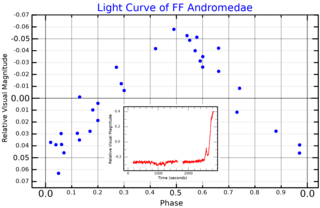
FF Andromedae is a spectroscopic binary in the constellation Andromeda. It has a typical apparent visual magnitude of 10.4, but undergoes flare events that can increase its brightness by about a magnitude.

GR Andromedae is a variable star in the constellation Andromeda. Its apparent visual magnitude varies between 6.87 and 6.95 in a cycle of 518.2 days. It is classified as an α2 Canum Venaticorum variable.

KX Andromedae is a spectroscopic binary star in the constellation Andromeda. Its apparent visual magnitude varies between 6.88 and 7.28.
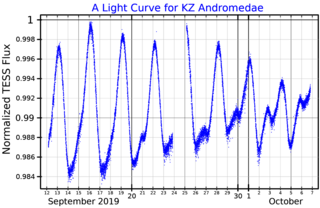
KZ Andromedae is a double lined spectroscopic binary in the constellation Andromeda. Its apparent visual magnitude varies between 7.91 and 8.03 during a cycle slightly longer than 3 days.

QR Andromedae is an eclipsing binary star in the constellation Andromeda. Its maximum apparent visual magnitude is 12.16, but its light curve shows clearly eclipsing events where its brightness can drop to a magnitude of 13.07. This leads to its classification as an Algol variable star.
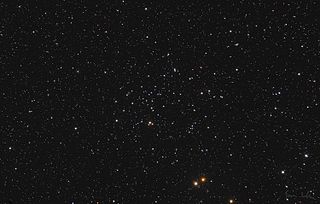
QX Andromedae is an eclipsing binary in the constellation Andromeda. It varies from a maximum apparent visual magnitude of 11.28 to a minimum of 11.50. Since it is impossible to specify the onset time of the eclipses, it is classified as a W Ursae Majoris variable star. It is also observed as an X-ray source and is a member of the open cluster NGC 752.

V455 Andromedae is a dwarf nova in the constellation Andromeda. It has a typical apparent visual magnitude of 16.5, but reached a magnitude of 8.5 during the only observed outburst.


















